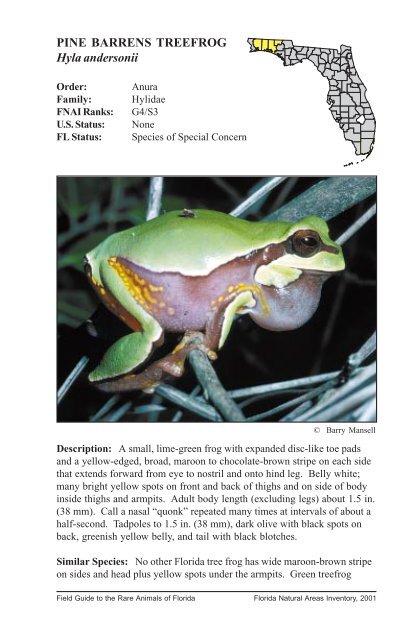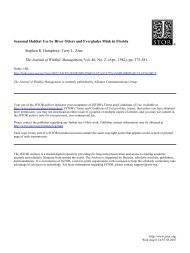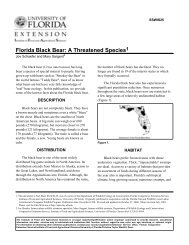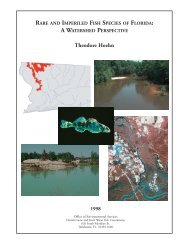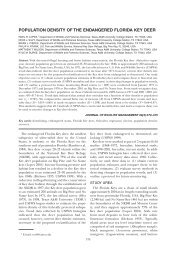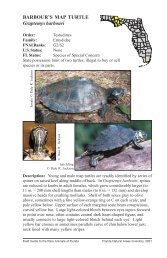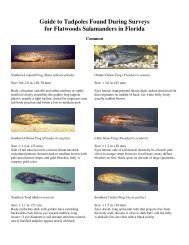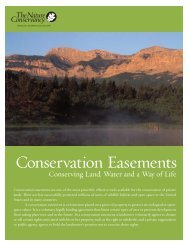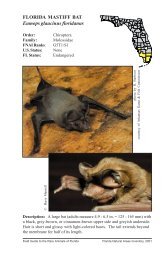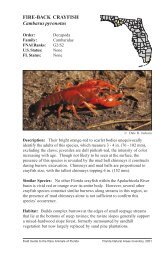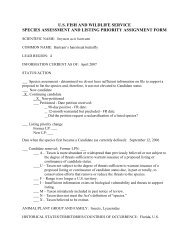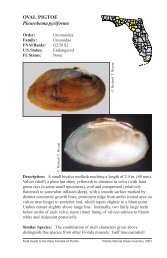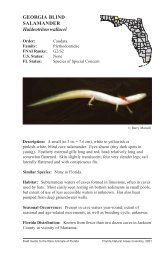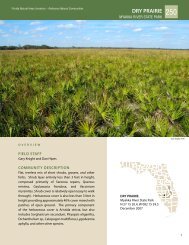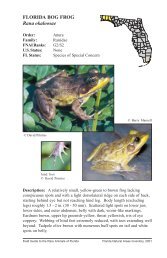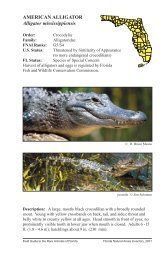PINE BARRENS TREEFROG Hyla andersonii - Florida Wildlife ...
PINE BARRENS TREEFROG Hyla andersonii - Florida Wildlife ...
PINE BARRENS TREEFROG Hyla andersonii - Florida Wildlife ...
Create successful ePaper yourself
Turn your PDF publications into a flip-book with our unique Google optimized e-Paper software.
<strong>PINE</strong> <strong>BARRENS</strong> <strong>TREEFROG</strong><br />
<strong>Hyla</strong> <strong>andersonii</strong><br />
Order:<br />
Family:<br />
FNAI Ranks:<br />
U.S. Status:<br />
FL Status:<br />
Anura<br />
Hylidae<br />
G4/S3<br />
None<br />
Species of Special Concern<br />
© Barry Mansell<br />
Description: A small, lime-green frog with expanded disc-like toe pads<br />
and a yellow-edged, broad, maroon to chocolate-brown stripe on each side<br />
that extends forward from eye to nostril and onto hind leg. Belly white;<br />
many bright yellow spots on front and back of thighs and on side of body<br />
inside thighs and armpits. Adult body length (excluding legs) about 1.5 in.<br />
(38 mm). Call a nasal “quonk” repeated many times at intervals of about a<br />
half-second. Tadpoles to 1.5 in. (38 mm), dark olive with black spots on<br />
back, greenish yellow belly, and tail with black blotches.<br />
Similar Species: No other <strong>Florida</strong> tree frog has wide maroon-brown stripe<br />
on sides and head plus yellow spots under the armpits. Green treefrog<br />
Field Guide to the Rare Animals of <strong>Florida</strong> <strong>Florida</strong> Natural Areas Inventory, 2001
<strong>PINE</strong> <strong>BARRENS</strong> <strong>TREEFROG</strong><br />
<strong>Hyla</strong> <strong>andersonii</strong><br />
(<strong>Hyla</strong> cinerea) is more elongate and has a distinct, narrow, white or yellow<br />
line on each side and extending along jaw-line; its call is similar but lowerpitched<br />
and at longer intervals. Barking treefrog (H. gratiosa) usually has<br />
circular dark spots on back. Squirrel treefrog (H. squirella) is small and<br />
usually has ragged white line on side. Pine woods treefrog (H. femoralis)<br />
has bright yellow spots on back of thighs but nowhere else and is usually<br />
brown. Gray (H. chrysocelis) and bird-voiced (H. avivoca) treefrogs,<br />
although usually gray, can turn green; back pattern on both resembles tree<br />
bark, and skin is slightly warty.<br />
Habitat: Acidic seepage bogs, both herbaceous and shrubby, draining<br />
sandy uplands. Water shallow and clear, sphagnum moss abundant.<br />
Common trees and shrubs include titi, sweet bay magnolia, fetterbush, red<br />
maple, tulip poplar, black gum, gallberry, pepperbush, and St. Johns wort.<br />
Extent of use of surrounding uplands is unknown.<br />
Seasonal Occurrence: Calls March - September; tadpoles present May -<br />
August.<br />
<strong>Florida</strong> Distribution: Western panhandle, mostly in tributaries of the<br />
Blackwater and Yellow rivers and Choctawhatchee Bay.<br />
Range-wide Distribution: Three widely disjunct regions: New Jersey pine<br />
barrens, North and South Carolina, and western <strong>Florida</strong> and adjacent<br />
southern Alabama.<br />
Conservation Status: Most <strong>Florida</strong> populations are within Eglin Air Force<br />
Base and Blackwater River State Forest.<br />
Protection and Management: Protect streams from siltation, pollution,<br />
and excess surface runoff, all of which are threats to habitat where roads<br />
cross slopes above streams; move or close roads as needed. Avoid damming<br />
streams within range. Burn adjacent uplands to retard development of<br />
hardwood forests along streams; allow fire to encroach into herbaceous<br />
bogs.<br />
Selected References: Ashton and Ashton 1988a, Bartlett and Bartlett<br />
1999, Conant and Collins 1991, Means and Longden 1976, Means and<br />
Moler 1979, Moler 1981, Moler (ed.) 1992, Mount 1975.<br />
Field Guide to the Rare Animals of <strong>Florida</strong> <strong>Florida</strong> Natural Areas Inventory, 2001


